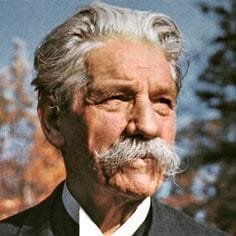
by admin | Jun 4, 2022 | History
François Vidocq
The Enchanting Tale Of The French Sherlock Holmes François Vidocq is one of the people with the most exciting life stories. He was an inspiration for more than Sherlock Holmes, with writers like Victor Hugo, Edgar Allan Poe and Honoré de Balzac basing some of their characters on this criminal turned private detective.
This is his story.
He was born in France in 1775 in a region called Arras. The family had a total of six children wtih François falling in the middle. He had a raudy adolescence, during which he cemented himself as a great fencer. A skill which would come in handy later. His first arrest is an interesting story. At the age of 13 he stole some of his parents’ silverware to try and sell it and was later caught and detained by police.
After spending two weeks in prison, he was released but even before that, he suspected that his father was behind the arrest in an attempt to teach him a lesson.It turned out the young boy was right – his father did contact and work with the policemen. Just one year later, François ran away from home and tried reaching the Americas. The plan he made was unsuccessful and so he ended up joining a traveling circus to make ends meet.
After trying different jobs in the show and hearing that the circus is near his hometown, he came back to his parents, begging for forgiveness. He wound up staying in Arras until 1791, when he joined the French military force. One year later, the young man was promoted to corporal but during the ceremony, he challenged a superior officer to a duel.
The older man refused, so Vidocq hit him, an action so outside the law it could have gotten him the death penalty, which is exactly why he deserted and joined a different regimen. Soon after that, however, Vidocq went home and got married. He was 19 years old at the time and married because of a pregnancy scare.
When he found out not only that he wouldn’t have a kid but that his wife was cheating on him, he left. The Frenchman spent some time in Brussels under the alias “Rousseau” where he met some interesting characters but decided the place wasn’t for him and moved to Paris. There, he fell in love with another woman, Francine, who left him soon after they started dating.
François beat both of them, for which the soldier sued him. This is how Vidocq was sentenced to three months in prison again. While inside, he was accused of assisting in the forgery of another inmate’s papers and had to stand a second trial. During this time, Vidocq broke out multiple times thanks to Francine but was always caught after a little while.
On one of his escapes, Francine caught him with another woman, and after he was brought back to prison, he was told she was found with multiple self-inflicted knife wounds but was still alive. Because of his behavior, the police moved him to a few different prisons, from all of which he tried to escape, and he succeeded in gaining his freedom in Brest.
François disguised himself as a sailor and was apprehended weeks later by policemen because of a lack of papers. He made up a fake name, and while they were checking his story, the police put him in a prison hospital. He escaped from there too, this time by stealing a nun’s clothes, and was found some months later and brought to a different prison.
After just a few months in this location, he escaped with the help of a prostitute. After some smaller adventures, Vidocq moved back to Arras in 1800. He spent some time being a merchant, but his past caught up to him. He was arrested, informed of his divorce, and sentenced to death. François filed an appeal, and while waiting for a retrial he fled again and lived outside the law for four more years.
In 1809, when he was caught again by the police, he offered them a peculiar deal – to become their informant. It was hard to refuse such skills, so the French officers agreed. He was put in La Force prison as a spy and started giving information to the French chief of police – Jean Henry – about everything. Unsolved crimes, fake identities – all sorts of information was passed through thanks to this new role.
It was because of a job well done that the chief gave the recommendation for François to be released. In order for it not to look suspicious to the criminal underworld, the release was staged like an escape. Being obligated to Henry, Vidocq kept on working for the police. Using disguises as well as his notorious fame, he managed to get information about both crimes that were already committed and those that were only just planned.
He was so good at his job that in 1813 Napoleon signed a decree establishing an entire state police force of which François was the leader. A large part of the employees were ex-criminals like himself. Being like-minded to those who he was catching, Vidocq was a master at his new official job.
In just one year – 1817 – he was involved in 811 arrests. Although he was considered a wanted man for a long time after he started working for the police, this all changed when king Luis XVIII officially pardoned him that same year. Soon after, he remarried, but both his wife and mother died just four years later.
Because of political changes in France, Henry, who was still his immediate superior, retired. A new and very conservative chief was employed with whom François didn’t get along. In 1827, the 52-year-old criminal turned policeman resigned. After yet another marriage, a couple of years, a failed business, and a robbery, which he solved for the police, Divocq was again appointed chief of his police department.
However, there were many rumors that he was a part of the robbery he solved, and a lot of the people working in the force did not approve of his methods, namely that he worked with ex-criminals. After just two years, François resigned again, and the department was reestablished without agents with criminal records. In 1833 François opened the first detective agency, almost entirely staffed with ex-convicts.
From 1837 he constantly quarreled with the police, and at some point, they even confiscated more than 3 500 files and imprisoned him. Because of unsound evidence, he was later released. He wrote several small autobiographies during this period, and after that, it was time for yet another change. After a few similar run-arounds, the political situation in France changed again, and François started working for the new authorities.
His job was the surveillance of Napoleon Bonaparte. Not long after though, the country’s laws and staff changed again, and François, already old, decided to retire. He went to jail one last time in 1849 for fraud, but the charges were dropped. His living situation took a turn for the worse, and he lost the majority of his fortune in bad investments and had to live in rented accommodations.
He got sick from cholera, and although he consistently beat it for the first three years, his condition deteriorated tragically in 1857. He died in his home in Paris at the age of 81. The location of his grave is still unknown. The tale of François Divocq is an example of a life that is fascinating and full of adventures.
He didn’t abide by the law, which got him in a lot of trouble, but it also built skills that were extremely valuable for him later on in life. There is a lot that can be learned from people like him, both seen as cautionary tales and inspirational stories. Regardless of the point of view you choose, one thing is sure – his story is definitely interesting.

by admin | May 31, 2022 | Mind, History
The Founder Of Neuropsychology – Brenda Milner
The 103-year-old lady who holds the title “founder of neuropsychology.” Brenda Milner is one of the most famous names in the field of neuropsychology in the world. She has more than 20 awards and has made some groundbreaking discoveries concerning memory, brain damage, and language. She’s a member of the royal society both in London and in Canada, and she teaches and researches to this very day.
This is her story.
Brenda Milner was born in 1918 in Manchester with two musicians as parents. Her father taught her mathematics when she was a child and when she started studying in Newham College Cambridge, this was her initial field. However, she soon changed it to psychology and graduated in 1939.
Soon after, she was given a research studentship, allowing her to stay in the university for two more years. With the start of the second world war, the Cambridge psychology laboratory was tasked with researching aircrew selection. Milner’s task specifically was designing tests to distinguish future fighter pilots and bomber pilots.
After this, she continued working to help in the war, investigating different methods to ease radar operators, which is how she met her husband. Peter Milner was an electrical engineer who was also recruited, just like her. They married in 1944 and moved to Canada, where he was invited to help with atomic research while she started teaching psychology at the University of Montreal.
In 1952 Brenda earned her Ph.D. in experimental psychology with a thesis on the intellectual effects of temporal lobe brain damage. In 1954 she published a research paper about temporal lobe damage and how it can cause emotional and intellectual changes, thus discouraging invasive surgeries on humans that could negatively impact their lives.
She was later invited to Hartford to study patient Henry Molaison and, in doing so, became a pioneer in the field of neuropsychology concerning memory and cognitive functions. Patient H.M. had undergone a bilateral temporal lobectomy which included removing major portions of the hippocampus and Brenda Milner studied the effects this damage had on his memory and cognitive ability.
What she found out is that the brain damage affected his memories from a few years before the surgery but those from further in the past remained intact. She also explained that while he is unable to form new memories, he can learn new cognitive abilities. For example, she spent three days teaching H.M. a simple but different way to draw a star, and after those 3 days, he could use the newly learned technique even though he had no memory whatsoever of any events that occurred in those three days.
This led to her realization that there are different types of memory and learning. She split them into episodic memory and procedural memory, one being the recollection of everyday events, while the other is connected with doing unconscious tasks.
She was also the first to introduce the concept of multiple memory systems and their different places in the brain, which led to researching other areas of the brain to find where specific memories are stored. Brenda Milner had another breakthrough concerning the lateralization (the tendency for the brain to use mainly one of its two hemispheres concerning specific processes) of the brain and its connection to language.
Here she came to the conclusion that hand preference and speech are connected and, based on that, managed to prove that brain lesions have an effect on the way our brain is organized physically. She recently deals with brain activity in more ordinary cases, specifically bilingualism and spatial memory.
Milner donated 1 million dollars (gathered mainly from praise money) to the Montreal Neurological Institute after establishing a foundation in her name. Throughout her life, she has received many awards and memberships. She is part of the royal society both in London and in Canada and the National Academy of Sciences in the USA.
She has received the Gerard, the Balzan, and the Kavli prizes, all connected with neuroscience, and was given the national academy of sciences award for her research in brain regions in learning, language, and memory. She continues to teach and research to this day. She’s a professor in neurology and neurosurgery at the McGi Universityity as well as a Dorothy J. Killam Professor at the Montreal neurological institute.
All in all, Brenda Milner is one of the brightest minds today. Her work has influenced the lives of countless people both because of her findings and the changed perspective of other doctors. She’s the pioneer in neuropsychology right now and is simply amazing in what she did and continues to do.

by admin | May 30, 2022 | History
Alan Watts
Or The Man Who Built Bridges Between Worldviews Alan Watts was an English philosopher and speaker who lived in the 20th century and was one of the most influential thinkers of his time. He is famous for popularizing Asian traditions and philosophies, namely Buddhist, Taoist, and Hindu beliefs in the Western world.
He was also one of the first people to start talking about the different forms of psychedelics in his literature. He wrote a whopping amount of books (more than 25) in his lifetime, a few of them becoming bestsellers. He was also recognized for his lectures, talks, and broadcasts all over the world.
This is his story.

Alan Wilson Watts was born in 1915 in England to a businessman father and a housewife mother. His interest in Asian culture and Buddhism was formed at an early age because of two main things. One – he was raised by an Anglican Christian family on his mother’s side and had Christian training in his boarding school.
The latter he often described as “grim and maudlin,” which translates his opinion on this sort of teaching quite prominently. Two – he had an interest in Asian culture and art ever since he was a kid, describing them as flowing of life and showing the connection between man and nature.
Also, as a teenager, he spent most of his holidays with a close person who had a lot of knowledge and books on Buddhism and other eastern philosophies, having similar beliefs herself. At the age of 16, Alan took the first step to choosing Asian beliefs over Christian ones and became the secretary of the London Buddhist Lodge.
He became fascinated with the study of Zen, and although he didn’t study it formally, it remained one of his bigger interests. He later married Eleanor Everett, who was also interested in Asian culture, and in 1938 they moved to the US. After some time, they divorced, and he was married two more times to different women.
When he started living in the USA, he obtained a master’s degree in Theology and began teaching in the American Academy of Asian Studies alongside some of the more prominent Asian professors.
He also started learning the Chinese language and scripture. His lectures in the academy were extremely popular and often transformed into late-night open talks which took place in local coffee shops. In 1953, after leaving the academy, he started working in a radio station and began airing a broadcast that lasted more than ten years.
There are many radios which to this day still have a weekly Alan Watts program because of its lasting popularity. While working on the radio, he published one of his more famous books – The Way Of Zen, which deals with the general philosophy and history of Zen. During this time, Alan also published a book in which he explains his relationship with psychedelics.
A very famous quote depicting his view on this type of substance is, “If you get the message, hang up the phone. For psychedelic drugs are simply instruments, like microscopes, telescopes, and telephones. The biologist does not sit with eyes permanently glued to the microscope. He goes away and works on what he has seen.”
In the late 60s, Watts was seen by the public as a spiritual figurehead in the “counterculture” movement – a worldview about a more peaceful way of life. This group of people opposed the Vietnam war, commercialism, and bigger societal norms, and Alan was one of their most avid speakers.
Watts believed in social over personal ethics.
This was valid both for man’s relationship with nature and the governments’ relationship with individual citizens. He tried his best to be a bridge between culture and nature, East and West, more ancient beliefs, and modern life. Alan shared these views with the world in the best way he knew how – by talking about them. He had many lecture tours during his last years, between which he spent his time writing in Druid Heights – an artistic bohemian countryside in the mountains of California.
He died there aged 58 after one such tour in the US, Canada, and Europe. His lectures became even more famous after his death, and many people deem them just as relevant today. You can find his work in almost all forms of communication – books, videos, and broadcasts about him and his life or simply his lectures are all easily accessible and very popular.
Alan Watts was certainly a memorable person who led a peculiar life. The influence he had and the lasting relevance of his ideas are a resounding statement that his way of thinking was interesting, to say the least. We believe that learning about people like him broadens our perception of the world. So grab one of his books and see his ideas for yourself!

by admin | May 30, 2022 | History
Albert Schweitzer
A Man With Many Talents
People overall are extremely talented and capable. We can do multiple things and constantly improve them just because it makes us feel good. This man is a great example of how a person can achieve a lot in a lifetime if he sets his mind to it. Here is the story of Albert Schweitzer.
Bibliography

Albert Schweitzer was born in 1875 in Alsace, France, and grew up there. His father was a pastor in the local church, which was the place of worship both for Protestants and Catholics. That’s why he adopted the view that Christianity as a whole should support both types of faith and try to unite them.
His love for music is also rooted around this church – he started playing the organ when he was just ten years old. As he grew up, he started loving music more and more, but his main interest kept on being religion. He obtained a theology degree at the University of Strasbourg with a PhD dissertation on “The Religious Philosophy Of Kant.”
He continued to study the piano throughout his youth and managed to visit the Bayreuth Festival, which was dedicated to one of his favorite composers – Richard Wagner. At the age of 30, he started studying medicine in order to obtain a degree and be allowed to work as a physician.
Soon after he took his final exams, he married Helene Bresslau, and both of them moved to Africa to work. They came back to France during the First World War, and then he returned alone to Gabon to finish building his hospital. When he came back to Europe, he started writing his most precious work – “the Reverence for life.”
In his personal life, things changed a lot as well. He had a daughter, and the entire family moved to Germany. After many more but smaller adventures, the family settled there. He died in his own hospital in Gabon in 1965. After his death, his house in Germany became a museum.
Theology

Albert Schweitzer published two books regarding religion. The first one (which established his reputation) was about how people see Jesus. In that book, he argues that most religious people view Christ too romantically, which was not the original purpose. He believes that Jesus and his followers should be seen for their hardships and realism, not for their divinity.
The second book was also controversial. Its main purpose is to distinguish two sorts of mysticism – primitive and developed. For the author, primitive mysticism is one which cannot make sense of the universal or eternal. In contrast, a developed mysticism sheds light not only on these monumental topics but also on our relationship with them.
Music

Albert was the pioneer regarding a few things connected with music.
He was the first to interpret Bach’s music with symbols and pictures which gave the start of a new understanding and teaching of Bach’s art in general. This opened the doors for Schweitzer and his dear friend Widor to co-find the Paris Bach Society. In later years he was asked to play as the organist in Spain, and he regularly performed in Paris.
He was also the first to propose mixing the German and French versions of the organ (they have different pipe systems) and to later have this improved version built. The musician even received his very own pedal piano – an instrument resembling the organ in sound.
Medicine
After obtaining his medical degree, Albert and his wife moved to Gabon, Africa, and established their very own hospital. In the first 9 months alone, they took care of more than 2000 patients, some of which traveled for days to reach the location. They built their first actual building just before World War I broke out but had to leave it behind and return to France.
After taking care of his health Albert came back, this time without his wife, to finish what he started. Although everything was decayed and a lot of patients needed looking after, he and the locals managed to rebuild everything. Not only that, new hospital wings were added, and a secure medical team was assembled. After three years of incredibly hard work, Schweitzer returned to his wife, leaving behind a fully functioning hospital.
Reverence For Life
This is the work of the author for which he received a Nobel Peace Prize in 1952. In it, he explains his visions on philosophy. For him, the reality is objectively neutral – it holds no faith. Ethics then should be humankind’s responsibility. He sees every single person as responsible for his or her own faith and worldview.
According to him, respect for others was a natural phenomenon. Albert believed that the will for life is innate, and love is both an evolutionary necessity and a spiritual idea. He also connects this belief to that of Buddhists.
Albert Schweitzer was a very interesting man that led a fascinating life. He was an avid pianist, a theologian, and a philosopher. His life was filled with hardships, but he got through them all thanks to his way of thinking. We believe that he is a source of inspiration, if not for his specific talents, for his dedication.














